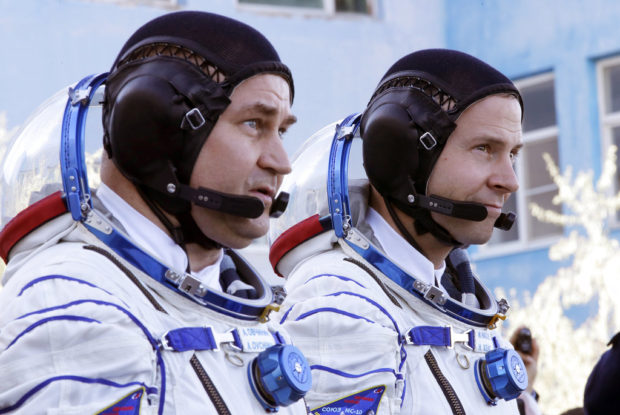US, Russian astronauts safe after emergency landing

US astronaut Nick Hague (right) and Russian cosmonaut Alexey Ovchinin, member of the main crew of the expedition to the International Space Station (ISS), walk prior to the launch of Soyuz MS-10 space ship at the Russian leased Baikonur cosmodrome, Kazakhstan on Oct. 11, 2018. AP
BAIKONUR, Kazakhstan — Two astronauts from the US and Russia were safe after an emergency landing Thursday in the steppes of Kazakhstan following the failure of a Russian booster rocket carrying them to the International Space Station.
NASA astronaut Nick Hague and Roscosmos’ Alexei Ovchinin lifted off as scheduled at 2:40 p.m. (0840 GMT; 4:40 a.m. EDT) Thursday from the Russia-leased Baikonur cosmodrome in Kazakhstan atop a Soyuz booster rocket.
Roscosmos and NASA said the three-stage Soyuz booster suffered an emergency shutdown of its second stage. The capsule jettisoned from the booster and went into a ballistic descent, landing at a sharper than normal angle and subjecting the crew to heavy G-loads.
NASA said that rescue teams have reached Hague and Ovchinin and they’ve been taken out of the capsule and were in good condition. The capsule landed about 20 kilometers (12 miles) east of the city of Dzhezkazgan in Kazakhstan. The launch failure marks an unprecedented mishap for the Russian space program, which has been dogged by a string of launch failures and other incidents in recent years.
“Thank God, the crew is alive,” Russian President Vladimir Putin’s spokesman, Dmitry Peskov, told reporters when it became clear that the crew had landed safely. He added that the president is receiving regular updates about the situation.
Article continues after this advertisementThe astronauts were to dock at the International Space Station six hours after the launch, but the Soyuz booster suffered an unspecified failure and shut down minutes after the launch.
Article continues after this advertisementSearch and rescue teams were immediately scrambled to recover the crew and other paratroopers were dropped from a plane to reach the site and help the rescue effort. Dzhezkazgan is about 450 kilometers (280 miles) northeast of Baikonur. Spacecraft returning from the ISS normally land in that region.
It was to be the first space mission for Hague, who joined NASA’s astronaut corps in 2013. Ovchinin spent six months on the orbiting outpost in 2016.
Roscosmos chief Dmitry Rogozin, who watched the launch together with NASA Administrator Jim Bridenstine, tweeted that a panel has been set up to investigate the cause of the booster failure.
Earlier this week, Bridenstine emphasized that collaboration with Russia’s Roscosmos remains important.
Relations between Moscow and Washington have sunk to post-Cold War lows over the crisis in Ukraine, the war in Syria and allegations of Russian meddling in the 2016 US presidential vote, but they have maintained cooperation in space research.
The Russian Soyuz spacecraft is currently the only vehicle for ferrying crews to the International Space Station following the retirement of the US space shuttle fleet. Russia stands to lose that monopoly in the coming years with the arrival of the SpaceX’s Dragon v2 and Boeing’s Starliner crew capsules.
Thursday’s failure was the first manned launch failure for the Russian space program since September 1983 when a Soyuz exploded on the launch pad. Soviet cosmonauts Vladimir Titov and Gennady Strekalov jettisoned and landed safely near the launch pad, surviving the heavy G-loads without injuries.
Russia has continued to rely on Soviet-designed booster rockets to launching commercial satellites, as well as crews and cargo to the International Space Station.
While Russian rockets had earned a stellar reputation for their reliability in the past, a string of failed launches in recent years has called into doubt Russia’s ability to maintain the same high standards of their manufacturing.
Glitches found in Russia’s Proton and Soyuz rockets in 2016 were traced to manufacturing flaws at the plant in Voronezh. Roscosmos sent more than 70 rocket engines back to production lines to replace faulty components, a move that resulted in a yearlong break in Proton launches and badly dented Russia’s niche in the global market for commercial satellite launches.
In August, the International Space Station crew spotted a hole in a Russian Soyuz capsule docked to the orbiting outpost that caused a brief loss of air pressure before being patched.
Rogozin, the Roscosmos chief, has raised wide consternation by saying that an air leak spotted at the International Space Station was a drill hole that was made intentionally during manufacturing or in orbit.
He didn’t say if he suspected any of the current crew of three Americans, two Russians and a German aboard the station of malfeasance. /ee